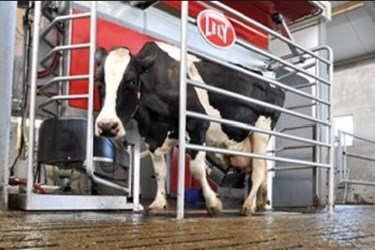Farm Robots Are Automating The Milking Process
By Alec Italiano, contributing writer

Want a happier cow and more milk? Let the cow decide when it is time to be milked
Technology has led farmers to an increasingly marginalized era of their trade. To address the needs of the changing industry, it is only natural that farmers turn to more technology for answers. In upstate New York, cows are being milked by automated robots — essentially milking themselves — changing the way dairy farms have operated for generations. Tech savvy farmers are upgrading their equipment to this brand new technology in an effort to make dairy operations more efficient.
These automated robots are popping up in barns across the dairy belt in New York and Pennsylvania, replacing the milking parlors most dairymen used to milk as many cows at once. This automation not only makes it easier on the farmer, but it also makes the milking process much easier on the cow. This process works through transponders swinging around the neck of each cow, tracking information such as milking speed, the amount and quality of milk she produces, frequency of visits, how much the cow has eaten, and even how many steps the cow takes day. Lasers then scan the underbelly of the cow, charting where to attach the mechanical milk cups and sends data back to the transponder to be recorded.
Check out how an organic dairy boosted its efficiency
Letting the cow determine when it should be milked, rather than having the farmer designate milking time, is important as well. Animals simply line up to walk through the machine to be milked, and can do so up to six times per day. A cow will be in distress if not milked. This automation allows for that cow to make her own milking schedule, thus increasing output.
With each machine costing roughly $250,000, they should pay themselves off in seven or eight years through labor savings and a more efficient supply chain. This allows for the farmer to be more of a cow manager, giving them more time to care for the animals, not to mention the added bonus of the opportunity to catch a bit more shuteye.
Of course there will still be problems, such as sick animals and machines breaking down, but automation in the milk industry seems to be a win-win so far. The farmer’s quality of life has improved, the cow is happier, with more quality milk is being produced as a result, and the decision to keep the farm doors open becomes a lot easier for those families contemplating default.
